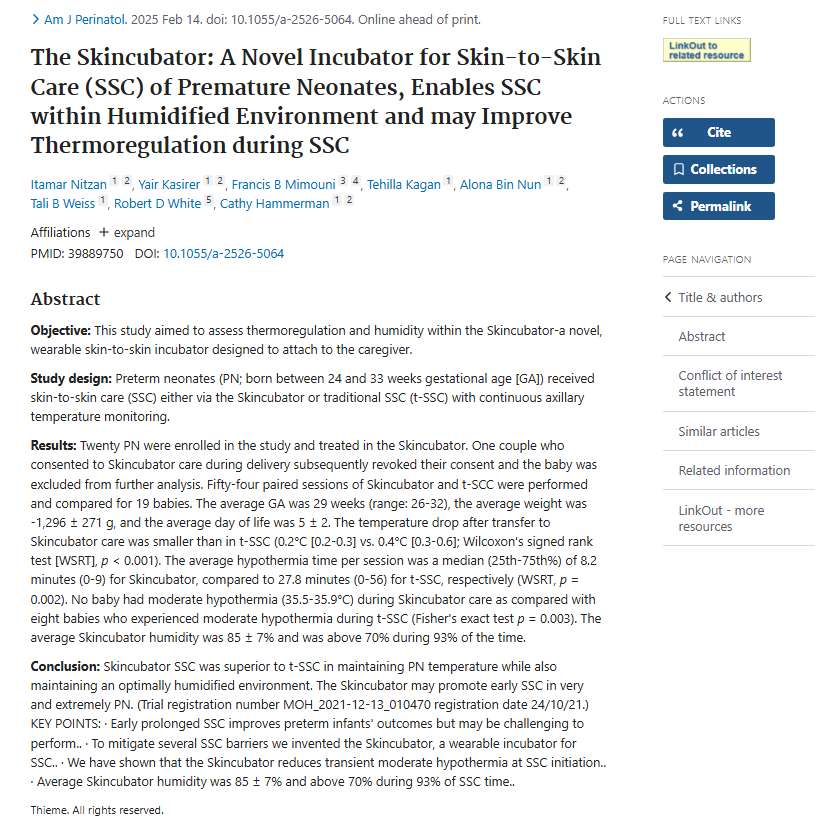Clinical Trials and Testing
We have treated dozens of very and extreme preterm infants and their parents so far, with excellent results.
Safety Study
A prospective single-center clinical study evaluated the safety and thermoregulation of the Skincubator version 1.1 for SSC in 20 neonates born <32 weeks' gestation and/or <1.5 kg. Key safety endpoints included maintenance of target body temperature, absence of respiratory instability or line/tube dislodgement.
-
The Skincubator reduces transient mild and moderate hypothermia during SSC as compared to traditional SSC.
-
No adverse events (e.g., moderate hypothermia, dislodgement of lines, desaturations requiring session termination) occurred.
-
Average Skincubator humidity was 85±7% and above 70% during 93% of SSC time.
The study was accepted for publication by the American Journal of Perinatology in May 2025.

Second Safety Study
An additional clinical feasibility evaluation was conducted on a more advanced Skincubator prototype with improved ergonomic features and tube access. Nine preterm infants (including invasively ventilated extreme preterm infants) were enrolled for SSC sessions using the updated model. Findings:
-
All sessions were completed without adverse events or safety concerns, after some minor modifications in the Skincubator transfer mechanism it worked smoothly in all transfers.
-
Parents rated the safety and convenience of Skincubator SSC higher than traditional SSC.
-
As compared to common SSC in the unit, parents were able to perform with the Skincubator longer and more frequent sessions (up to 4.2 hours per session and almost 9 hours per day).
-
Parents highlighted the ability to rest and even sleep while the baby is safely secured in the Skincubator. (
-
Nursing staff noted a feeling of confidence with the baby secured in the Skincubator during SSC.
The study has been submitted for peer-review.

Nursing Study
At the level IV NICU at Monash Children’s Hospital, Melbourne, Australia, a structured simulation study with 20 NICU nurses was conducted. It’s goal was to evaluate perceived safety and convenience of the Skincubator device vs. traditional SSC. Nurses transferred a manikin (configured as either a 29-week gestation neonate on CPAP or a 25-week gestation intubated neonate with umbilical lines) from incubator to caregiver using the Skincubator and performed common nursing procedures on the manikin within the Skincubator. Those procedures included common routine care and emergency situations.
Key Findings:
-
Nurses were very satisfied or satisfied with transferring the baby to the incubator for a short break and performing procedures such as a heel stick, obtaining a blood gas sample, and suctioning a tube in the Skincubator.
-
They rated the Skincubator as safer with less handling and more convenient than t-SSC for those procedures.
-
Nurses were more satisfied with securing a loose EET in the Skincubator than in t-SSC. Still, they were only neutral about the safety of performing this procedure in the Skincubator. Those findings were shared with the Skincubator design team, and a design change was promoted to improve access to the baby in case of EET securement needs.
The study has been submitted for peer-review in June 2025. The abstract of the article was accepted as an abstract to present at the Pediatric American Society conference in April 2025
